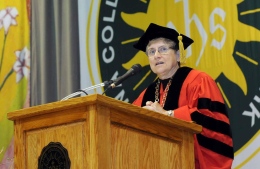By Patrick Hosken
Contributing Writer
On a Tuesday afternoon last November, Sister Margaret Carney, O.S.F., told me a few stories about how music has metaphorically tapped her on the shoulder at a few key moments in her life.
From the windows in her office in Hopkins Hall, the sun began to disappear into a mess of gray-blue clouds outside. I explained the premise of my journalism capstone project — the power of music in the lives of individuals — to her. Sister Margaret immediately reached behind her desktop computer, grabbed a cassette tape of Andrew Lloyd Webber’s 1984 composition Requiem and set it down in front of me.
Then she started her story.
When she was a graduate student at Bonaventure, Sister Margaret lived in what is now the Damietta Center (which she helped establish in 2006). One day, she took a call from one of her sisters, who told her their youngest sister was in weak condition in the hospital. Sister Margaret sat and worked away on a grad assignment, all the while the austere Requiem sounds filled the room.
When “Pie Jesu” came on, however, she froze.
“All of a sudden, this played and I just stopped,” Sister Margaret said. “I couldn’t write. I couldn’t think. It was like I was in another place. Without the words actually forming in my mind as I was hearing the music, I was saying to myself, ‘My sister is going to die.’ And an hour later, I got the call that she had died, and I think she died within the timeframe that I was hearing the music. So for me, that was my sister’s farewell to me.”
Sister Margaret called “Pie Jesu” a “haunting, haunting melody,” and that becomes truer with each listen of the piece. Webber created Requiem after his father’s death as a way to deal with the grief, Sister Margaret added. So, in a strange way, it’s universally applicable to everyone dealing with death.
“It’s sung by a boy soprano and a chorus, and it’s basically part of the standard Latin text of a mass to bury someone,” Sister Margaret said, “So when you hear it, what you hear is this piercing voice of a very young person, and the words are, ‘Merciful Jesus, take away the sins of the world; grant them rest.’”
Sister Margaret can still remember the hallway in Francis Hall where she took to a payphone to call home. The music still stops her. With such a monumental event imprinted in her memory, how can it not? That’s part of the reason she keeps the cassette — the same tape she listened to when her sister died — right on her desk. It’s sacred to her.
But it’s not just Requiem that Sister Margaret nurtures a relationship with. On a trip to Ireland with her sister, Sister Margaret discovered the wonderfully atmospheric music of Irish singer Enya in a restaurant called The Singing Salmon on the Dingle Peninsula. After the waitress gave them Enya’s name, Sister Margaret and her sister “scoured” music stores in Dublin two days later to find her music. It was just that striking to them.
“The first time I heard her music, it gave me chills,” she said. “The combination of Gaelic lyrics, Irish instrumentation, all that technology that creates this special sound … she sings the harmonies, and they re-record until they get all the tracks in there.”
When she talks about music, Sister Margaret speaks with energetic fervor. It’s clear she cares just as deeply as anyone, especially when she explained to me Sting recorded an entire album of early Renaissance music originally written by John Dowland. She understands the supremacy of song, especially when she talked of how the entire student section should sing “Don’t Stop Believin’” at Bonaventure basketball games to show the big-city teams the Bonnies aren’t afraid of them.
So, when it came time for her to somberly tell me about how her former teacher and colleague, Bishop Luigi Padovese, was brutally murdered in June 2010, I waited to see where the music fit into the story.
Bishop Luigi worked to promote interfaith relations between Muslims and Christians in Turkey, Sister Margaret said. When Pope Benedict XVI planned to visit Cyprus, just south of Turkey, Bishop Luigi arranged to welcome him there. He told his driver (a man possibly involved with a Muslim extremist planning an attempt on the pope’s life) he would not be coming with him, and the driver gruesomely stabbed him to death, nearly beheading him.
What makes the murder so chilling is that Bishop Luigi was a wonderful singer who had recorded himself singing different types of tunes to distribute to his friends — and he was stabbed in the throat. Sister Margaret only recently heard Bishop Luigi’s voice on the CDs.
“I listened to them for the first time, and I don’t have words to describe the feeling,” Sister Margaret said, “Because I realize this man had a beautiful, beautiful singing voice … and all I could think of was, ‘I never heard him sing, and his throat was slashed.’ So just this awful, awful feeling of the world being robbed of that.”
Throughout every entry in my capstone project, the aim was to prove that music is transcendent, that it’s vital to the very nature of human existence. Sister Margaret summed it up perfectly near the end of our interview with the eloquent, succinct phrase, “The spiritual bond that music supplies.”
That sure makes one heck of a tagline.
“I think you’re right, that the music becomes a way of holding onto the bond, which is very lovely,” she said.
So, in the midst of all the horror, cruelty and misfortune of this world, there’s music to help us attempt to understand it, or at the very least recognize it and simply feel it intensely. And then there’s ethereal music (like Enya’s) that helps us understand the pure power of it all.
Part of the mission statement for my capstone read, “While it might be true that there are no more original stories, the similarities of all our stories pull us closer as humans.”
Sister Margaret’s story in particular has proven that.
A version of this story appeared on someoneelsessong.wordpress.com as part of Patrick Hosken’s capstone project about pivotal musical moments in the lives of Bonaventure community members.






